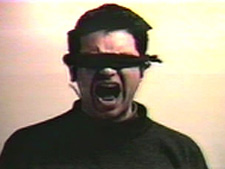Rodrigo Alonso
 |
|
 |
| Guillermo Cifuentes. Night Lessons. Video. 35 min. 1997-98. |
 |
Hernan Khourian. Areas. Video. 86 min. 2000. |
 |
Certainly, Latin America is not a unified region. This becomes absolutely evident if we take a look at its various landscapes and cultures: if something has characterized the cultural production of this suspicious geographical territory it is the extreme diversity of regional impulses.
Nevertheless, at the time to asses the situation of Latin American video art, the diagnosis seems to endlessly repeat: absence of official support policies, delayed technological access, insufficient spaces for theoretical reflection, marginalization, lack of production systems and financial sources, indifference form the rest of audiovisual areas —cinema, television, multimedia— about its destiny. It could be said, without much irony, that if something unifies Latin American video art it is the constancy of its obstacles and difficulties.
Those difficulties are not limited only to artistic production. The urge of Latin American reality seems to hit the artists in a special way, and their works are not indifferent. This fact determines the important current of overtly political works, rooted in the particular histories and social lives of each country that, even claiming for singular attention upon particular experiences and identities, print a fire mark on this electronic production as a whole.
With procedures inspired in Guerrilla-TV —as image appropriation from television— or by means of a particular language, these works build up non-official images of vernacular cultures, pointed out to unveil thought structures, ideological constructions and prejudices, in an overt contrast to the superficiality and spectacularity of socially distributed media images, in particular, those generated by the mass media.
This political trend does not shadow other kinds of proposals, conceptual, poetical or even narrative. Maybe because of the fore-mentioned cultural diversity, multiplicity has become a constant in Latin American video art. That heterogeneity translates into hybrid compositions that reveal their visual architecture of multiple influences, both local and foreign.
In opposition to its precarious production system, there are important academic centers and well established diffusion circuits in Latin America. But fundamentally, there are excellent artists, many times with an international recognition before a local one. In a further example of their attitude against official realities, Latin American video artists transcend frontiers, conveying images of a world they feel it is, or should be, different. |
Presented at:
Turbulence Zone. Ateneum Salii, Helsinki, 2002.
|

